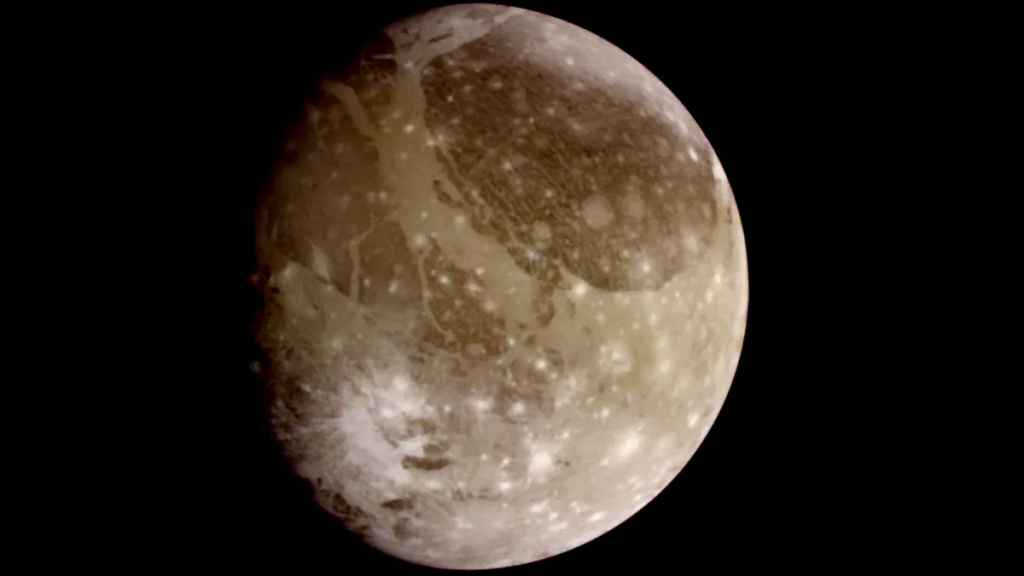Iron flakes at the heart of a Jupiter moon

Turbulence generated by falling particles (in white), to better understand the interior of planets and their magnetic field. Quentin Kriaa, Provided by the author
In these images, we look at turbulent swirls fueled by falling glass beads in water. This is our simplified model of the “iron snow” that exists in the cores of some planets.
Some planets generate their own magnetic fields through the movement of liquid metal in their cores – a process called a “dynamo” at work on Earth. Indeed, the Earth is large enough for the pressure to induce a solidification of the liquid metal from the center of the core towards its periphery, thus promoting large convection movements which feed the magnetic field of our planet.
On the other hand, on small terrestrial planets, the pressure is too low to allow this crystallization from the center of the planet. The latter can even be reversed: it is then done from the periphery of the core, at the border with the mantle. This is a plausible scenario for Ganymede , a satellite of Jupiter.

In this case, when the liquid metal crystallizes at the periphery of the core, iron flakes are formed, denser than the liquid metal. With nothing under their feet to hold them, they fall towards the center of the planet by gravity, and melt when they reach too high temperatures – like snow.
With our experiments, we are trying to understand what powers the dynamo movement in these small planets. One of the hypotheses is that the liquid metal is stirred up by this “snow” of solid iron flakes which fall into the liquid metal.
From the core to the lab
To model and better understand this “iron snow” phenomenon, physics must be simplified. Crystallization and melting of the flakes are temporarily set aside, the complex shape of the flakes is approximated by a sphere, and the materials are replaced.
So, in the laboratory, we look at the flow generated by the fall of glass spheres (aka flakes) into water (aka liquid metal, of the same viscosity as water). By probing the interior of the flow using a vertical laser sheet, our photos reveal that the fall of the glass particles, in white, does not leave the fluid indifferent: they produce turbulent clouds, with swirls visible using rhodamine, an orange dye. We observe a very similar phenomenon of turbulence when we put sugar in our coffee (if the beans are numerous and concentrated enough!).

These images provide a fascinating observation: in each of the three photos, exactly 1 gram of glass spheres falls, but the larger the particles (from left to right), the smaller and more ephemeral the cloud they generate. Because it is indeed the presence of particles which fuels the turbulence; as soon as the particles escape from the vortices, they slow down before coming to rest, the viscosity of the water inevitably dissipating any movement.
The tendency of large particles to be less sensitive to vortices, and therefore to separate from them quickly, is an effect of inertia that we experience every day: outside, for a given wind speed, a small chick's feather follows better and longer than a large pigeon feather, less sensitive to air movements. Due to this inertia, the gram of small particles is more capable of maintaining a turbulent cloud by its simple sedimentation in initially immobile water.
For iron flakes, there are several ways to “force” the flow
Several previous works on iron snow have not made it possible to decide whether the flakes significantly mix the fluid during their fall, so that the study of their sedimentation has sometimes been neglected . However, our experiments, the results of which will soon be submitted for publication, suggest that the flakes can have different behaviors that move the liquid metal, notably into a turbulent cloud.
On the other hand, this same work showed that the dynamo can come from “compositional convection”: the melting of numerous flakes at a given depth would accumulate an excess of liquid iron, denser than the rest of the liquid metal, inevitably leading to a rapid diving of this melted snow into depth – like a sheet of water overlooking oil. This is what we will now study by making sugar snow in water, to add to our model the ingredient of the melting of the flakes, modeled by the dissolution of the sugar.

An article from The Conversation written by Quentin Kriaa (Doctoral student in fluid mechanics, IMéRA), Benjamin Favier (researcher, Aix-Marseille University -AMU), Michael Le Bars (Research Director at CNRS, specialized in geophysical fluid mechanics and astrophysics, Aix-Marseille University – AMU)
Source : websites

